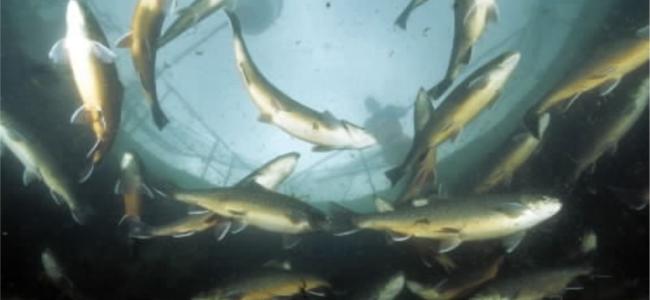Configure Now
Items in Your Cart0
0Items in Your Cart
Start building your packageShop Now
In exactly two weeks, a few of us from the Deep Trekker team will be in Norway at one of the largest aquaculture conferences in the world: AquaNor. This year the conference is being held in Trondheim, Norway and we are extremely excited to be showcasing our ROVs in our 200 gallon test tank. If you are planning on attending the conference be sure to stop by booth E-448 to say hello, chat over a drink with us and pilot our ROV for yourself.
In preparation for the conference we have been doing everything we can to brush up on the Norwegian aquaculture industry. I thought it would be great to share with all of you some of the main facts surrounding the Norwegian aquaculture industry and demonstrate why it is one of the leading countries when it comes to the farming and cultivation of fish.
Learn about Deep Trekker ROVs in Aquaculture.

Norway is the world’s leading producer of Atlantic salmon the second largest seafood exporter in the world. The introduction of large-scale aquaculture operations in Norway took place in 1970 and has expanded rapidly since. Today, approximately 160 municipalities along the Norwegian coastline are home to various aquaculture operations; mainly producing salmon and trout. The production of Atlantic salmon in particular has been growing continuously and has doubled since 2005.
One of the main factors that makes Norway among the leading aquaculture nations is its commitment to sustainable practices and efforts to minimize environmental impacts as much as possible. With the production of fish within farms, critiques of the industry have follow suit closely behind. While not all operations around the world could be classified as environmentally safe and healthy farming, Norway has seemed to take these concerns seriously and implement many regulations and practices to help combat poor farming practices.
Upon developing a strategy to minimize the environmental risks associated with the industry, the Norwegian government has identified 5 main areas of concern within the aquaculture industry.
These areas include:
Learn how ROVs can improve the production on a fish farm and reduce environmental impacts in this video – Top 6 uses for ROVs in aquaculture.
One of the reasons we are so excited to be visiting Norway and to experience firsthand the aquaculture practices is because of the nation’s commitment to sustainability. Here at Deep Trekker we are huge proponents of environmental sustainability and Norway is considered to be right on track in regards to aquaculture.
Right from the introduction of aquaculture in Norway the farmers have been working closely with scientists to develop the industry - and the more you know about operations and impacts, the easier it is to combat potential issues.

“To become a world leader in aquaculture, Norway has depended on a combination of strict health regulations, close safety monitoring and continuous work to develop the industry.” For example, in Norway every farm must be licensed and certified in an environmentally appropriate location to avoid impacts on the surrounding ecosystems and wild fish populations.More than $18 million is set aside annually to fund aquaculture research and development.
Another major concern that critics of aquaculture will often bring up is that fish net pens are crowded and do not allow the fish sufficient space to grow. In Norway, the industry must ensure at least 97.5% of open water volume to allow salmon the freedom to grow to full size in a clean and natural environment. That means that only 2.5% of the space is actually occupied by the fish themselves. After all, farmers want to have happy and healthy fish.
We believe that aquaculture is a necessary industry to combat world hunger and provide enough protein to the global population without allowing the wild fish populations to diminish. That being said, we do recognize that in some areas aquaculture operations do not use best practices and can have negative impacts on the environment, that is why when we learn about a nation that is successfully avoiding negative environmental impacts we try to share this information.
We have a number of our units being used on farm sites within Norway and they have seen tremendous success in helping farmers avoid fish escapes, as well as allowing operation managers and employees the ability to constantly check up on their farms. We are extremely pleased to play even a small part in reducing the environmental impacts that the industry could potentially have.
To read about some of the main escape prevention practices check out our post here: //www.deeptrekker.com/escape-prevention-practices/
Additional resources: http://www.fisheries.no/aquaculture/Aquaculture/#.VcERw_lVhBc
http://www.seafood.no/B%C3%A6rekraft/Aquaculture-in-Norway/Aquaculture-in-Norway
April 22nd, 2025
FLAIMS 2024 showcased SAR teams integrating ROVs, sonar, and drones, advancing...
April 4th, 2025
Join Deep Trekker and Navtech Radar at Ocean Business 2025 to...
April 3rd, 2025
Advanced ROV training at Deep Trekker Headquarters helped H2O Drones improve...